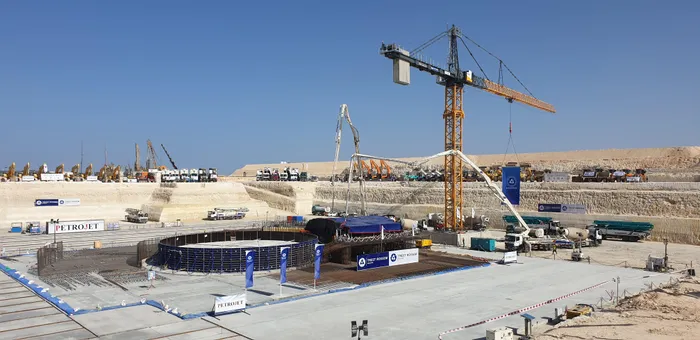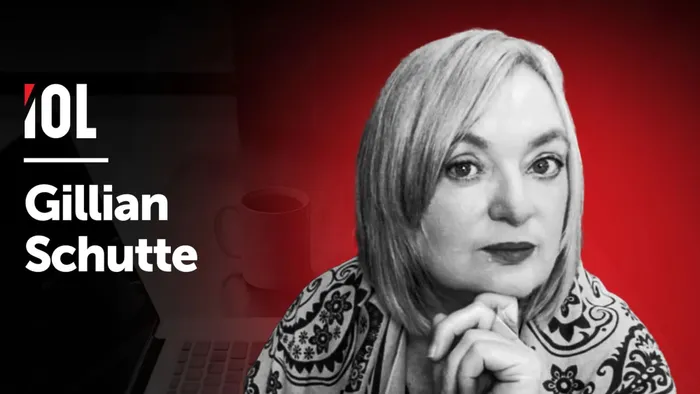Africa's Atomic Deals Take Shape in Moscow – South Africa Waits in the Wings

Pouring the first concrete in the foundation plate of the power unit Number 2, November 19, 2022, at the El Dabaa Nuclear Power Plant in Egypt. El Dabaa is the first nuclear power plant in Egypt, located about 320 kilometres northwest of Cairo. The plant will have four VVER-1200 reactors, making Egypt the only country in the region to have a Generation III+ reactor. On November 19, 2015 Egypt and Russia signed an initial agreement, under which Russia would build and finance Egypt’s first nuclear power plant.
Image: ASE
World Atomic Week 2025 ended with Africa firmly on the map of nuclear development. Ethiopia signed a roadmap for its first nuclear power station, Niger committed to building two reactors to finally harness its own uranium reserves, and Egypt reaffirmed construction milestones at El Dabaa. Meanwhile, Rwanda, Ghana, and Kenya advanced talks on nuclear science centres and modular designs. Across the continent, leaders presented nuclear power as a lever for sovereignty, equity, and industrial growth.
South Africa, by contrast, confined its contributions to technical panels on nuclear medicine, isotope production, and safety standards. These were valuable, yet they left Pretoria absent from the high-level energy commitments now shaping Africa’s industrial century.
Rosatom’s appeal lies in the completeness of its offer. Its contracts cover the entire nuclear life-cycle: Generation III+ VVER-1200 reactors with advanced passive safety systems, long-term Russian credit covering up to 85% of project costs, guaranteed uranium supply, and lifetime operational support. Training is central, with hundreds of African engineers already studying in Russia, while waste management and decommissioning plans are built into the deals. Unlike Western financing frameworks, which mostly enforce conditionality through debt, austerity requirements, and restrictive procurement rules, Rosatom’s approach builds capacity and ensures African participation at every stage. Technology transfer, local industrial contracts, and skills development are part of the agreements, meaning African states are equal partners in shaping outcomes. This is why projects progress from agreement to construction in years rather than decades.
South Africa has placed enormous trust in the donor-driven Just Energy Transition (JET). On paper, it aligns with climate goals and the need to shift away from coal. In practice, most of the promised finance comes as loans rather than grants, and the structure directs resources into closing coal stations without providing stable baseload replacements. Renewables are vital, but they cannot yet support an industrial grid on their own. Even with record investment in solar and wind, rolling blackouts have only intensified. The JET does more than expose technical gaps—it entrenches dependency on Western lenders and narrows South Africa’s energy options. Its frameworks serve donor priorities while leaving domestic needs unmet. What is promoted as a just transition risks becoming a transition managed from outside, one that weakens sovereignty and deepens economic vulnerability.
Nuclear belongs firmly in the green debate. It produces almost no carbon emissions during operation, and across a 60-year lifecycle its carbon footprint is as low as, or lower than, wind and solar once mining, manufacturing, and recycling are factored in (IAEA). The economics tell their own story. Eskom’s figures put Koeberg’s primary energy cost at about 9.9 c/kWh, cheaper than the tariffs for new wind and solar projects under the current IRP window. Koeberg has provided reliable electricity for nearly forty years, and the life extension programme of Koeberg’s units will support that record into the 2040s. Renewables are essential to South Africa’s future, but their intermittency means storage and backup must be built in, which raises their system cost. Nuclear, by contrast, delivers constant baseload power, keeping the grid stable and allowing renewables to expand without compromising energy security.
Small Modular Reactors (SMRs) highlight nuclear’s adaptability. With outputs of 50–300 MW, they are factory-built, quicker to deploy, and easier to finance than traditional mega-projects. Their advanced designs use passive safety features such as gravity-fed shutdowns, underground containment, and natural cooling, significantly reducing risk. For South Africa, SMRs could be placed on decommissioned coal sites, reusing existing transmission lines and water infrastructure. They would preserve jobs, provide incremental baseload, and anchor renewable-heavy regions. These projects also embed South African engineers, regulators, and technicians into the process, creating skills that can later be exported to other African markets. Rosatom has already proven the SMR concept with its Akademik Lomonosov floating reactor in the Arctic. Deploying such technology at home would keep South Africa’s nuclear expertise active and position the country at the forefront of global nuclear innovation.
The Zuma-era nuclear plan continues to overshadow energy policy. The secrecy of the negotiations and the scale of projected costs were valid concerns and led to its collapse in court. Yet the central idea—that South Africa needed a new generation of nuclear plants—was not misguided. The country had authorised sites, trained engineers, and a regulator prepared to oversee expansion. The failure lay in governance, not in the recognition of nuclear as a pillar of energy security. The lesson is to pursue nuclear projects transparently, incrementally, and with financing structures open to public scrutiny. The experience should be treated as a learning curve, not as a veto on the technology itself.
Within BRICS, nuclear energy has become a strategic instrument of multipolar development. Rosatom’s projects in Egypt, Ethiopia, and Niger are evidence of African states setting their own energy path beyond Western enforcement frameworks. For South Africa, working with Rosatom through BRICS mechanisms—the New Development Bank, shared research, and coordinated training—offers financial flexibility and geopolitical alignment. From a foreign policy perspective, energy independence is inseparable from sovereignty. Anchoring nuclear development within BRICS structures would allow Pretoria to balance Western partnerships with multipolar alternatives. It would enhance South Africa’s role as both a continental leader and a credible global negotiator at a time when energy security is emerging as the defining factor in global politics.
The cost of delay is mounting. Load shedding has already stripped trillions from the economy, weakened investor confidence, and forced small businesses into closure. Skilled nuclear professionals are leaving to work on VVER-1200 projects abroad in Egypt, Asia, and the Gulf. Extending Koeberg’s Unit 1 to 2044, and applying for a similar extension for Unit 2 beyond 2025, buys time but does not solve the crisis. Pretoria now faces a strategic choice: remain tethered to externally managed frameworks, or act decisively to secure its energy future. Nuclear is not in opposition to renewables—it is the stable base that allows them to thrive. With Rosatom’s full-spectrum packages, SMRs for incremental deployment, and BRICS financing, South Africa can stabilise its grid, expand renewables, and rebuild industrial confidence.
Energy defines destiny. Africa’s nuclear dawn is already breaking in Addis Ababa, Niamey, and El Dabaa. South Africa has the infrastructure, expertise, and history to lead, yet it remains hesitant, waiting in the wings while others move forward. Decisiveness is overdue. Nuclear and renewables together can secure South Africa’s energy sovereignty, revitalise its economy, and re-establish its leadership in Africa’s energy future. The turbines at Koeberg still turn—the question is whether Pretoria will turn with them, or leave the nuclear century to others.

Africa is rapidly advancing in nuclear energy, with Ethiopia, Niger, and Egypt leading the charge. As these nations forge ahead, South Africa's lack of engagement raises questions about its energy future and sovereignty.
Image: IOL
* Gillian Schutte is a South African writer, filmmaker, poet, and uncompromising social justice activist. Founder of Media for Justice and co-owner of handHeld Films, she is recognised for hard-hitting documentaries and incisive opinion pieces that dismantle whiteness, neoliberal capitalism, and imperial power.
** The views expressed do not necessarily reflect the views of IOL or Independent Media.
Related Topics: